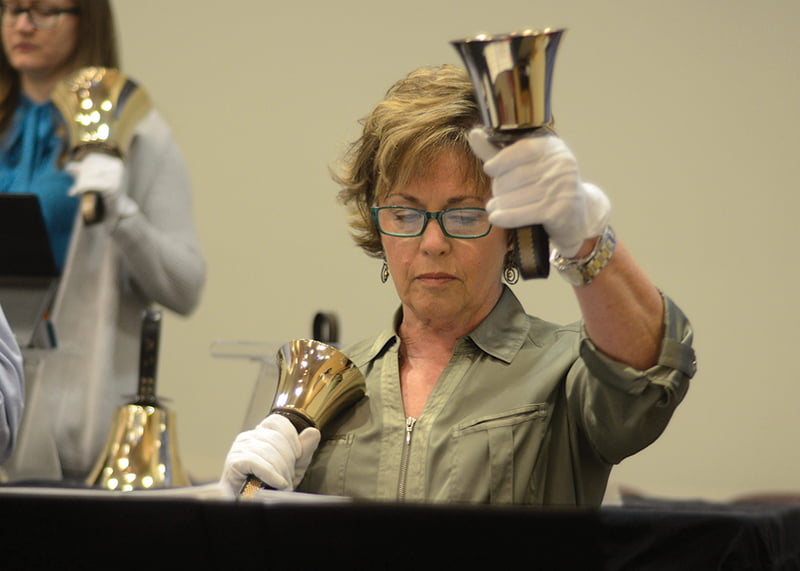
Susan Gasper is an integral part of the handbell choir. Even though she doesn’t read music, Gasper is able to play by marking her notes with colored pens that coordinate to her bells. LEAVEN PHOTO BY JILL RAGAR ESFELD
By Jill Ragar Esfeld
jill.esfeld@theleaven.org
LENEXA — Holy Trinity parishioner Helen McGown is a ringer who can shelley; and if you know anything about handbell technique, you know that’s impressive.
“Shelley means I have two bells in one hand,” she explained.
In the upper octaves, bells are so small it’s possible to use this technique.
“Most people will have a total of five bells in front of them,” McGown said. “I will have a total of 10 because I would play f6 and f7, which both have a sharp and a flat, to go with them.”
In other words, she knows her stuff. And she’s not alone.
The members of the handbell choir at Lenexa’s Holy Trinity, Bells of Joy, have made music together for more than 15 years.
To the casual observer, they may look like a group of people simply ringing bells. But to the ear, the sound is so heavenly you know it entails much more finesse.
“You have that melody going from ringer to ringer and the different rhythms,” said director Helena Vasconcellos. “And it’s very difficult.
“It’s very challenging because you have to know exactly how loud that person on your side is playing to continue that melody.”
The term “together” is the cornerstone of this group’s success, because ringers act as a single instrument.
“If you take one of the bell songs we play,” said McGown, “and everyone stood around a piano and had their finger on that one key and played it when it was their turn — that’s what it’s like.”
Much like the body of Christ.
“Exactly,” said McGown. “We’re all part of the whole with each one having a part to play.
“And when a part is missing, it can throw other people off.”
Even the smallest, most insignificant bell is critically important.
McGown has a degree in music, but it’s far from required to be in the group. At the other end of the line, literally, is Susan Gasper, who doesn’t even know how to read music.
“I use colored markers to follow the notes,” she said.
Handbell ringers, regardless of their level of experience, move and work together, learning first how to ring the bell and then learning technique.
“You can produce different sounds with your bells,” explained Vasconcellos. “You can use the mallets, you can ring the bells on the foam on the table, and you can use your thumbs to mute the sound.
“It’s a fascinating realm of music.”
Though the bells look like big sturdy chunks of metal, they’re actually very fragile.
Ringers wear gloves because oil from their hands can degrade the finish on them.
Bells must be polished, maintained and occasionally sent out for tune-ups.
“Even though they seem sturdy, they’re very easy to damage,” said Vasconcellos. “The equipment is very, very expensive. “
The bells were donated to Holy Trinity, and that was the impetus for putting together a choir.
A notice was put in the bulletin, and Jill Hagel, who still plays with the group, was the only respondent who had any experience with handbells.
Amy Knudsen was the group’s first director. She got the choir started, wrote accompaniments for the hymns and conducted for 10 years.
The reaction of the congregation when the handbells first rang at Mass?
“Oh, they were amazed,” said McGown.
When Knudsen left in 2013, McGown held the choir together until another director could be found.
Vasconcellos, who has a degree in piano performance and a second degree in conducting, was pleased to take over the seasoned group.
“I had been a choral conductor for a long time,” she said. “I decided to give this a try because I was always fascinated by the bells.
“I found a group of people who are so dedicated, so united and have such passion. It was a grace of God to be able to have them in front of me.
“It’s just a joy to work with them.”
The ensemble practices once a week and plays once a month, rotating Masses.
“We do a different program every time we ring,” said Vasconcellos. “And usually we have four rehearsals to learn new things.”
Dedication to attending rehearsals is essential because the fragile bells are only available for practice during that time.
Choir member Joan Immethun tapes rehearsals and posts them online so people can practice at home, but without the bells.
At home, you use spoons,” said McGown. “You have the music in front of you; you can listen online to what we just practiced and play your part with it.
“The bigger bell people might use a hammer.”
At the beginning of each practice, the handbell choir says a prayer that begins with the words: “Oh Lord, please bless this music that it might glorify your name.”
This attitude of serving God through music is at the heart of this choir.
“Everyone has the same mindset,” said Vasconcellos. “We are there just to enhance the liturgy, not to be acknowledged outside the church.
“It is very humbling to do such a beautiful work primarily for God.”






